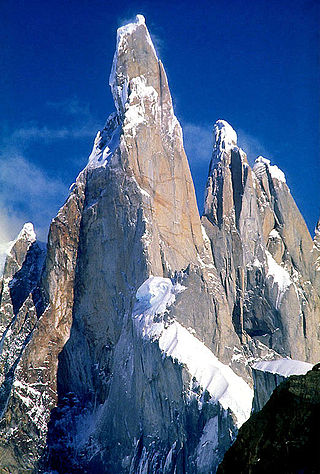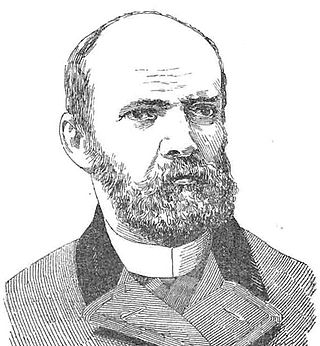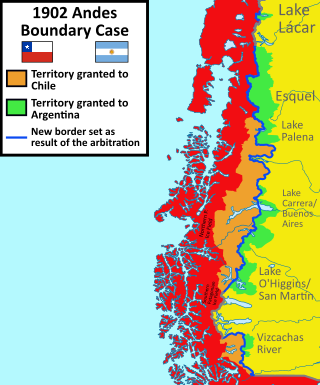
Santa Cruz Province is a province of Argentina, located in the southern part of the country, in Patagonia. It borders Chubut Province to the north, and Chile to the west and south, with the Atlantic coast to the east. Santa Cruz is the second-largest province of the country, and the least densely populated in mainland Argentina.

Cerro Torre is one of the mountains of the Southern Patagonian Ice Field in South America. It is located on the border dividing Argentina and Chile, west of Fitz Roy. At 3,128 m (10,262 ft), the peak is the highest of a four mountain chain: the other peaks are Torre Egger, Punta Herron, and Cerro Standhardt. The top of the mountain often has a mushroom of rime ice, formed by the constant strong winds, increasing the difficulty of reaching the actual summit.

Monte Fitz Roy is a mountain in Patagonia, on the border between Argentina and Chile. It is located in the Southern Patagonian Ice Field, near El Chaltén village and Viedma Lake. It was first climbed in 1952 by French alpinists Lionel Terray and Guido Magnone.

Diego Jacinto Agustín Barros Arana was a Chilean professor, legislator, minister and diplomat. He is considered the most important Chilean historian of the 19th century. His main work General History of Chile is a 15-volume work that spanned over 300 years of the nation's history.

This is a timeline of Chilean history, comprising important legal and territorial changes and political events in Chile and its predecessor states. To read about the background to these events, see History of Chile. See also the list of governors and presidents of Chile.

The Southern Patagonian Ice Field, located at the Southern Patagonic Andes between Chile and Argentina, is the world's second largest contiguous extrapolar ice field. It is the bigger of two remnant parts of the Patagonian Ice Sheet, which covered all of southern Chile during the last glacial period, locally called the Llanquihue glaciation.

Bernardo O'Higgins National Park is the largest of the protected areas in Chile, covering an area of 3,525,901 ha, in both the Aysén and Magallanes and Antártica Chilena regions. Management of this and other national parks in Chile is entrusted to the Corporación Nacional Forestal (CONAF). The park is named after General Bernardo O'Higgins, the first head of state of the Republic of Chile. Los Glaciares National Park (Argentina) and Torres del Paine National Park are its neighbours to the east, Laguna San Rafael National Park is located to the north, the Alacalufes National Reserve to the southwest, and the Katalalixar National Reserve to the northwest.

International relations between the Republic of Chile and the Argentine Republic have existed for decades. The border between the two countries is the world's third-longest international border, which is 5,300 km (3,300 mi) long and runs from north to south along the Andes mountains. Although both countries gained their independence during the South American wars of liberation, during much of the 19th and the 20th century, relations between the countries were tense as a result of disputes over the border in Patagonia. Despite this, Chile and Argentina have never been engaged in a war with each other. In recent years, relations have improved. Argentina and Chile have followed quite different economic policies. Chile has signed free trade agreements with countries such as China, the United States, Canada, South Korea, as well as European Union, and it's a member of the APEC. Argentina belongs to the Mercosur regional free trade area. In April 2018, both countries suspended their membership from the UNASUR.

The 1902 Arbitral award of the Andes between Argentina and Chile was a British arbitration in 1902 that established the present-day boundaries between Argentina and Chile. In northern and central Patagonia, the borders were established between the latitudes of 40° and 52° S as an interpretation of the Boundary treaty of 1881 between Chile and Argentina.

Del Desierto Lake or Lake of the Desert is a natural lake located in the Lago Argentino Department, Santa Cruz Province, Argentina. Located near Monte Fitz Roy and the O'Higgins/San Martín Lake, Lago del Desierto was for many decades the subject of a territorial dispute between Argentina and Chile, escalating to a small firefight on 6 November 1965 when 40 to 90 members of the Argentine Gendarmerie fought against four Chilean Carabineros, of which a lieutenant was killed and a sergeant was injured. The dispute was resolved favourably for Argentina in 1994 by international arbitration.
The Huilliche uprising of 1792 was an indigenous uprising against the Spanish penetration into Futahuillimapu, territory in southern Chile that had been de facto free of Spanish rule since 1602. The first part of the conflict was a series of Huilliche attacks on Spanish settlers and the mission in the frontier next to Bueno River. Following this a militia in charge of Tomás de Figueroa departed from Valdivia ravaging Huilliche territory in a quest to subdue anti-Spanish elements in Futahuillimapu.

The Circo de los Altares is a cirque glacier of the Patagonian Andes, located in the Southern Patagonian Ice Field, where Mount Torre and Mount Fitz Roy can be seen from its western sides. It is located within the Area in dispute between Chile and Argentina with the border being defined in the northern area of the site.

The Southern Patagonian ice field dispute is a border dispute between Argentina and Chile over the delineation of the boundary line between the two countries on the Southern Patagonian Ice Field, a large expanse of glaciers located in the Patagonian Andes, which is the largest non-polar continental ice field with land access. It is called continental ice in Argentina and southern ice field in Chile, to differentiate it from the northern ice field. As of 2024, the Argentine–Chilean border in this sector is still pending of definition according to the 1998 agreement signed by both countries. The original border was defined 100 years prior on 1 October 1898 by experts from both countries.
Cerro Agassiz or formerly Cerro Bertrand is a mountain in the Andes, located on the border between Argentina and Chile, in the Patagonia region. It stands at an elevation of 3,177 meters.
The Cerro Roma, Cerro Vivod, Cerro Bertrand, or Agassiz Norte is a mountain in the Andes, located on the border between Argentina and Chile, in the Patagonia region. The mountain reaches 3,180 m a.s.l. and is located near the westernmost point of Argentina, as defined by the 1998 agreement.

The Cerro Huemul is a glaciated mountain in the Andes located on the eastern edge of the Southern Patagonian Ice Field, west of Lake Viedma and north of the Viedma Glacier within the disputed area between Chile and Argentina.
The Cerro Cervantes is a mountain in the Southern Patagonian Ice Field with an elevation of 2,380 meters above sea level or 680 meters above the surrounding terrain. Its foothills are about 5.6 kilometers wide. It is located in Santa Cruz Province, Argentina, and is part of Los Glaciares National Park. Before the 1998 agreement between Argentina and Chile, this mountain was considered a border landmark by Chile.

Cerro Mayo or de Mayo is a mountain located in the Southern Patagonian Ice Field, in Santa Cruz Province, Argentina. It is part of Los Glaciares National Park.
Cerro Campana is a glaciated mountain in the Andes mountain range in Patagonia, located on the eastern edge of the Southern Patagonian Ice Field, west of Lake Viedma, and south of the glacier of the same name within the disputed area between Chile and Argentina.

The Alto Palena-Encuentro River border dispute was a territorial dispute between the Argentine Republic and the Republic of Chile over the demarcation of the boundary between landmarks XVI and XVII of their common border in the valleys located north of General Vintter/Palena Lake, and was resolved on November 24, 1966, by the arbitral ruling of Queen Elizabeth II of the United Kingdom.
















